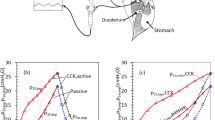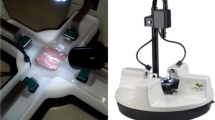Abstract
Biomechanical properties of human gallbladder (GB) wall in passive state can be valuable to diagnosis of GB diseases. In the article, an approach for identifying damage effect in GB walls during uniaxial tensile test was proposed and a strain energy function with the damage effect was devised as a constitutive law phenomenologically. Scalar damage variables were introduced respectively into the matrix and two families of fibres to assess the damage degree in GB walls. The parameters in the constitutive law with the damage effect were determined with a custom MATLAB code based on two sets of existing uniaxial tensile test data on human and porcine GB walls in passive state. It turned out that the uniaxial tensile test data for GB walls could not be fitted properly by using the existing strain energy function without the damage effect, but could be done by means of the proposed strain energy function with the damage effect involved. The stresses and Young moduli developed in two families of fibres were more than thousands higher than the stresses and Young’s moduli in the matrix. According to the damage variables estimated, the damage effect occurred in two families of fibres only. Once the damage occurs, the value of the strain energy function will decrease. The proposed constitutive laws are meaningful for finite element analysis on human GB walls.








Similar content being viewed by others
References
Amaral J, Xiao ZL, Chen Q, et al. Gallbladder muscle dysfunction in patients with chronic acalculous disease. Gastroenterology. 2001;120(2):506–11.
Bateson MC. Gallbladdr disease. BMJ. 1999;318:1745–8.
Becker W, Gross D. A one-dimensional micromechanical model of elastic-microplastic damage evolution. Acta Mech. 1987;70:221–33.
Behar J, Lee KY, Thomson WR, Biancani P. Gallbladder contraction in patients with pigment and cholesterol stones. Gastroenterology. 1989;97:1479–84.
Borly L, Hojgaard L, Gronvall S, Stage JG. Human gallbladder pressure and volume: validation of a new direct method for measurements of gallbladder pressure in patients with acute cholecystitis. Clin Physiol Funct Imaging. 1996;16(2):145–56.
Brotschi EA, Lamorte WW, Williams LF. Effect of dietary cholesterol and indomethacin on cholelithiasis and gallbladder motility in guinea pig. Dig Dis Sci. 1984;29(11):1050–6.
Cerci SS, Ozbek FM, Cerci C, et al. Gallbladder function and dynamics of bile flow in asymptomatic gallstone disease. World J Gastroenterol. 2009;15(22):2763–7.
Chaboche JL. Continuum damage mechanics: present state and future trends. Nucl Eng Des. 1987;105:19–33.
Fett T, Schell KG, Hoffmann MJ, et al. Effect of damage by hydroxyl generation on strength of silica fibers. J Am Ceram Soc. 2018. https://doi.org/10.1111/jace.15508.
Fung YC, Fronek K, Patitucci P. Pseudoelasticity of arteries and the choice of its mathematical expression. Am J Physiol. 1979;237(5):H620–31.
Genovese K, Casaletto L, Humphrey JD, et al. Digital image correlation-based point-wise inverse characterization of heterogeneous material properties of gallbladder in vitro. Proc R Soc Ser A. 2014;470:20140152.
Goussous N, Kowdley GC, Sardana N, et al. Gallbladder dysfunction: how much longer will it be controversial? Digestion. 2014;90:147–54.
Holzapfel GA, Gasser TC, Ogden RW. A new constitutive framework for arterial wall mechanics and a comparative study of material models. J Elast. 2000;61(1):1–48.
Karimi A, Shojaei A, Tehrani P. Measurement of the mechanical properties of the human gallbladder. J Med Eng Technol. 2017;41(7):541–5.
Kurtz RC. Progress in understanding acalculous gallbladder disease. Gastroenterology. 2001;120(2):570–2.
Lemaitre J. How to use damage mechanics. Nucl Eng Des. 1984;80:233–45.
Lemaitre J, Dufailly J. Damage measurements. Eng Fract Mech. 1987;28:643–61.
Matsuki Y. Spontaneous contractions and the visco-elastic properties of the isolated guinea-pig gall-bladder. Jpn J Smooth Muscle Res. 1985;21:71–8.
Matsuki Y. Dynamic stiffness of the isolated Guinea-pig gallbladder during contraction induced by cholecystokinin. Jpn J Smooth Muscle Res. 1985;21:427–38.
Mahadevan V. Anatomy of the gallbladder and bile ducts. Surgery. 2014. https://doi.org/10.1016/j.mpsur.2014.10.003.
Miura K, Saito S. Visco-elastic properties of the gallbladder in rabbit and guinea-pig. J Showa Med Assoc. 1967;27(2):135–8.
Li WG, Hill NA, Ogden RW, et al. Anistropic behaviour of human gallbldder walls. J Mech Behav Biomed Mater. 2013;20:363–75.
Li WG, Luo XY. An invariant-based damage model for human and animal skins. Ann Biomed Eng. 2016;44:3109–22.
Li Y. Trust region, reflective techniques for nonlinear minimization subject to bounds, technical report-CTC93TR152, Cornell Theory Center, Cornell University; 1993.
Portincasa P, Di Ciaula A, van Berge-Hengouwen GP. Smooth muscle function and dysfunction in gallbladder disease. Curr Gastroenterol Rep. 2004;6(2):151–62.
Rosen J, Brown JD, De S, et al. Biomechanical properties of abdominal organs in vivo and postmortem under compression loads. J Biomech Eng. 2008;130:021020.
Ryan J, Cohen S. Gallbladder pressure-volume response to gastrointestinal hormones. Am J Physiol. 1976;230(6):1461–5.
Schoetz DJ, LaMorte WW, Wise WE, et al. Mechanical properties of primate gallbladder: description by a dynamic method. Am J Physiol Gastrointest Liver Physiol. 1981;241:G376–81.
Stinton LM, Shaffer EA. Epidemiology of gallbladder disease: cholelithiasis and cancer. Gut Liver. 2012;6(2):172–87.
Voyiadjis GZ, Kattan PI. On the theory of elastic undamageable materials. J Eng Mater Technol. 2013;135:021002.
Voyiadjis GZ, Kattan PI. Decomposition of elastic stiffness degradation in continuum damage mechanics. J Eng Mater Technol. 2017;139:021005.
Xiong L, Chui CK, Teo CL. Reality based modelling and simulation of gallbladder shape deformation using variational methods. Int J Comput Assist Radiol Surg. 2013;8:857–65.
Author information
Authors and Affiliations
Corresponding author
Ethics declarations
Conflict of interest
The author has no conflict of interest.
Ethical approval
This article does not contain any studies with human participants or animals performed by the author.
Additional information
Publisher's Note
Springer Nature remains neutral with regard to jurisdictional claims in published maps and institutional affiliations.
Appendix: Custom MATLAB program for damage model
Appendix: Custom MATLAB program for damage model
The damage model described with Eqs. (6)–(15) was encoded in MATLAB by using a main program and a user function. At first, the experimental data of two uniaxial tensile tests presented with the curves in Fig. 2c are read into the main program after the curves were digitalized by employing a digitizer. The lower and upper bounds of nine model constants are specified. To ensure a global optimization process, the lower bound should be small enough while the upper bound should be large enough. Table 4 summarizes the lower and upper bounds applied in the parameter optimization process in the paper. For the model without damage effect the lower and upper bounds of \(\xi\) and \(\zeta\) are 108, and those of \(m\) and \(n\) are 1 to remove their effect on the model and restore the model represented by Eq. (1) without damage, but the bounds of the rest parameter are the same those in the model with damage.
The lsqnonlin function in MATLAB was chosen to carry out the parameter optimization by minimizing the objective function Eq. (2). In the lsqnonlin function, “trust-region-reflective” optimization algorithm is implanted. In the algorithm, the objective function is approximated with a model function i.e. a quadratic function. Trust region is a subset of the region of the objective function. The minimum objective function is achieved in the trust region. In the trust region algorithm, the search step and size of trust region are decided and updated according to the ratio of the real change of the objective function to the predicted change in the objective function by the model function to ensure sufficient reduction of the objective function. Such procedures can result in the trust region may be out of one bound. Thus, the search direction should be reflected to the interior region constrained by the bounds with the law of reflection in optics on that bound. Compared with Newton method and Levenberg–Marquardt algorithm, the trust-region-reflective algorithm can ensure the optimization iteration remaining in the strict feasible region and its convergence rate is in the 2nd-order [24].
Nine internal optimization variables in the lsqnonlin function [\(x_{1}\), \(x_{2}\), \(x_{3}\), …, \(x_{9}\)] were selected to represent nine parameters [\(c\), \(k_{1}\), \(k_{2}\), \(k_{3}\), \(k_{4}\), \(\xi\), \(n\), \(m\), \(\zeta\)] in the physical domain. However, the variables of [\(x_{1}\), \(x_{2}\), \(x_{3}\), …, \(x_{9}\)] in the computational domain of the lsqnonlin function is subject to the same lower bound 0 and upper bound 1, but also the step sizes for searching the optimum solution are identical to all the variable. Thus, a transformation relationship between [\(x_{1}\), \(x_{2}\), \(x_{3}\), …, \(x_{9}\)] in the computational domain and [\(c\), \(k_{1}\), \(k_{2}\), \(k_{3}\), \(k_{4}\), \(\xi\), \(n\), \(m\), \(\zeta\)] in the physical domain is needed. Here a linear relationship is employed and written as the followings
where the lower and upper bounds of nine parameters, such as \(c_{\hbox{min} }\), \(c_{\hbox{max} }\), \(k_{1\hbox{min} }\), \(k_{1\hbox{max} }\) and so on, have been listed in Table 4. Accordingly, the step sizes in the computational domain are related to those in the counterpart in the physical domain by the following from Eq. (A1)
Based on Eq.(A2), even though the step sizes of the internal variables [\(x_{1}\), \(x_{2}\), \(x_{3}\), …, \(x_{9}\)] are the same, i.e. \(\Delta x_{1}\) = \(\Delta x_{2}\) = \(\Delta x_{3}\) = ··· = \(\Delta x_{9}\) in the lsqnonlin function, the step sizes such as \(\Delta c\), \(\Delta k_{1}\), \(\Delta k_{2}\), …, \(\Delta \zeta\) in the physical domain still vary across the variables.
It was found that \(k_{1}\)(\(x_{2}\)) and \(k_{3}\)(\(x_{4}\)) vary little and affect the optimization results negligibly, but \(c\)(\(x_{1}\)) changes significantly during the optimization process. Therefore \(k_{1}\)(\(x_{2}\)) and \(k_{3}\)(\(x_{4}\)) have to be updated by \(c\)(\(x_{1}\)) after they were calculated with Eq. (A1) in the following manner
where \(k_{1}\) and \(k_{3}\) in the left-hand side have been determined by Eq. (A1).
Additionally, an initial nine parameters [\(c_{0}\), \(k_{10}\), \(k_{20}\), \(k_{30}\), \(k_{40}\), \(\xi_{0}\), \(n_{0}\), \(m_{0}\), \(\zeta_{0}\)] are generated randomly in the bounds by using rand function of MATLAB in terms of [\(x_{10}\), \(x_{20}\), \(x_{30}\), …, \(x_{90}\)] to make sure a global optimization process, i.e.
where \(x_{10}\) = rand(1, 1), \(x_{20}\) = rand(1, 1), \(x_{30}\) = rand(1, 1), …, \(x_{90}\) = rand(1, 1).
The option in the lsqnonlin function is as follows: MaxIter = 4000, TolFun = 10−8, TolX = 10−8, Diffminchange = 10−4, Diffmaxchange = 10−2 and MaxFunEvals = 50,000 where MaxIter is maximum number of iterations allowed, TolFun is termination tolerance on the objective function value, TolX is termination tolerance on [\(x_{1}\), \(x_{2}\), \(x_{3}\), …, \(x_{9}\)], Diffminchange and Diffmaxchange are minimum and maximum changes in variables for finite difference derivatives of the objective function, respectively; MaxFunEvals is maximum number of the objective function evaluations allowed.
The temporary nine parameters, stresses and objective function value at the experimental stretches are calculated in the user function. The user function is called repeatedly by the lsqnonlin function until a convergent optimization process arrives. The stress-stretch curves, strain energy function values, Young’s moduli, damage variables and relevant plots are figured out in the main program based on the determined nine parameters.
Rights and permissions
About this article
Cite this article
Li, W. Constitutive law of healthy gallbladder walls in passive state with damage effect. Biomed. Eng. Lett. 9, 189–201 (2019). https://doi.org/10.1007/s13534-019-00098-9
Received:
Revised:
Accepted:
Published:
Issue Date:
DOI: https://doi.org/10.1007/s13534-019-00098-9




